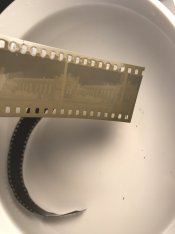willfrancis
Member
Hello all (I’m new here, so please be gentle...),
I recently decided to try and home process several rolls of (new) E100 that I’d shot over the summer, due to the exorbitant processing costs where I live. Being more intrepid than I am sensible, I set out to mix my own solutions rather than buy a kit. I followed Stefan’s ‘updated’ formulas for the FD and CD, along with his processing times, to the letter. For the reversal, I opted to go with a light reversal, using a 60w incandescent equivalent LED bulb to expose each side of the water-submerged reels for approx. 3 mins in a white bowl. I used an EDTA bleach and prebleach based on the Fuji formulae, and then a two stage NH3 thiosulphate fix followed by a formalin stabiliser.
Unfortunately, upon running a development for the first time, my two test films came out of the final bath very dark and almost opaque. Individual frames were just about distinguishable (as negatives) when peered at under strong light, but something had clearly gone quite wrong.
I then set out to work out what that something might have been, first re-bleaching/fixing part of one of the original rolls to see if the error was an insufficiency of either bath (there was no difference); assuming that everything after the CD was working as it should, I then substituted the FD for HC-110 B for 6 mins with a test strip. At the light reversal stage, I was pleased to see that the HC-100 developed negatives were significantly clearer than those at the equivalent stage after developing in my brewed FD, seemingly confirming my suspicions that the error was in my mixing of the FD. However, at the end of the process, despite the negatives’ earlier clarity, I found that they again emerged a dark-ish brown, with faint traces of the negative frames (see the attached images) - but certainly no colour, nor proper transparency of the emulsion. I’m thus feeling slightly stuck - there seems to be something wrong with both the FD and the CD, which is frustrating as I’d taken pains to be meticulous in mixing up all the solutions...
Has anybody else faced a similar problem before? Has anybody got some sort of idea what may have gone wrong? I did wonder whether I may have been colossally stupid and done something like labelling the two developers the wrong way round, but I don’t believe that I did... for reference, the appearance of the FD is pale yellow which turns a faint-ish pink when poured back into its bottle, slowly returning to the original colour with time. The CD has a similar original colour if slightly darker, but turns a deep, intense purple somewhat reminiscent of grape juice in the development tank. Again, after being returned to its bottle the colour fades and it regains a pale yellow hue.
Apologies for the essay - I just wanted to give as much detail as possible! Thanks very much.
I recently decided to try and home process several rolls of (new) E100 that I’d shot over the summer, due to the exorbitant processing costs where I live. Being more intrepid than I am sensible, I set out to mix my own solutions rather than buy a kit. I followed Stefan’s ‘updated’ formulas for the FD and CD, along with his processing times, to the letter. For the reversal, I opted to go with a light reversal, using a 60w incandescent equivalent LED bulb to expose each side of the water-submerged reels for approx. 3 mins in a white bowl. I used an EDTA bleach and prebleach based on the Fuji formulae, and then a two stage NH3 thiosulphate fix followed by a formalin stabiliser.
Unfortunately, upon running a development for the first time, my two test films came out of the final bath very dark and almost opaque. Individual frames were just about distinguishable (as negatives) when peered at under strong light, but something had clearly gone quite wrong.
I then set out to work out what that something might have been, first re-bleaching/fixing part of one of the original rolls to see if the error was an insufficiency of either bath (there was no difference); assuming that everything after the CD was working as it should, I then substituted the FD for HC-110 B for 6 mins with a test strip. At the light reversal stage, I was pleased to see that the HC-100 developed negatives were significantly clearer than those at the equivalent stage after developing in my brewed FD, seemingly confirming my suspicions that the error was in my mixing of the FD. However, at the end of the process, despite the negatives’ earlier clarity, I found that they again emerged a dark-ish brown, with faint traces of the negative frames (see the attached images) - but certainly no colour, nor proper transparency of the emulsion. I’m thus feeling slightly stuck - there seems to be something wrong with both the FD and the CD, which is frustrating as I’d taken pains to be meticulous in mixing up all the solutions...
Has anybody else faced a similar problem before? Has anybody got some sort of idea what may have gone wrong? I did wonder whether I may have been colossally stupid and done something like labelling the two developers the wrong way round, but I don’t believe that I did... for reference, the appearance of the FD is pale yellow which turns a faint-ish pink when poured back into its bottle, slowly returning to the original colour with time. The CD has a similar original colour if slightly darker, but turns a deep, intense purple somewhat reminiscent of grape juice in the development tank. Again, after being returned to its bottle the colour fades and it regains a pale yellow hue.
Apologies for the essay - I just wanted to give as much detail as possible! Thanks very much.












